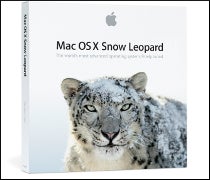 |
| Source: Apple |
News and analysis of Apple’s new release of OS X — version 10.6, dubbed “Snow Leopard” — have already begun making the rounds this week. With the update going on sale today, you’re certain to have seen plenty of reports assessing whether it’s worth it, whether it’s a must-have update, whether it’s an “important” milestone for the Apple Mac operating system.
But what precious few news outlets have spent much time pondering is that the new OS is smaller and faster than before.
Take a second to think about this.
With each subsequent release of OS X, the operating system’s performance has gotten better and better while hardware requirements have barely moved. Actually, until Snow Leopard’s debut, you could continue running the latest version of the operating system on hardware that existed even before OS X itself and still be realizing performance improvements.
And today, users may notice that with Snow Leopard, the operating system’s footprint on their hard drive has also begun decreasing. That’s right: OS X 10.6 takes up less space than 10.5 — while being faster and introducing new features.
Oh, yeah: Snow Leopard retails for $29.
Now Apple’s just showing off.
But the company’s superior approach to the OS can’t be denied. We have another example of how Apple’s is unique in the realm of mainstream consumer operating systems: OS X gets faster and more powerful each time without significantly upping its hardware requirements.
In the age of Windows Vista, this seems incredible.


